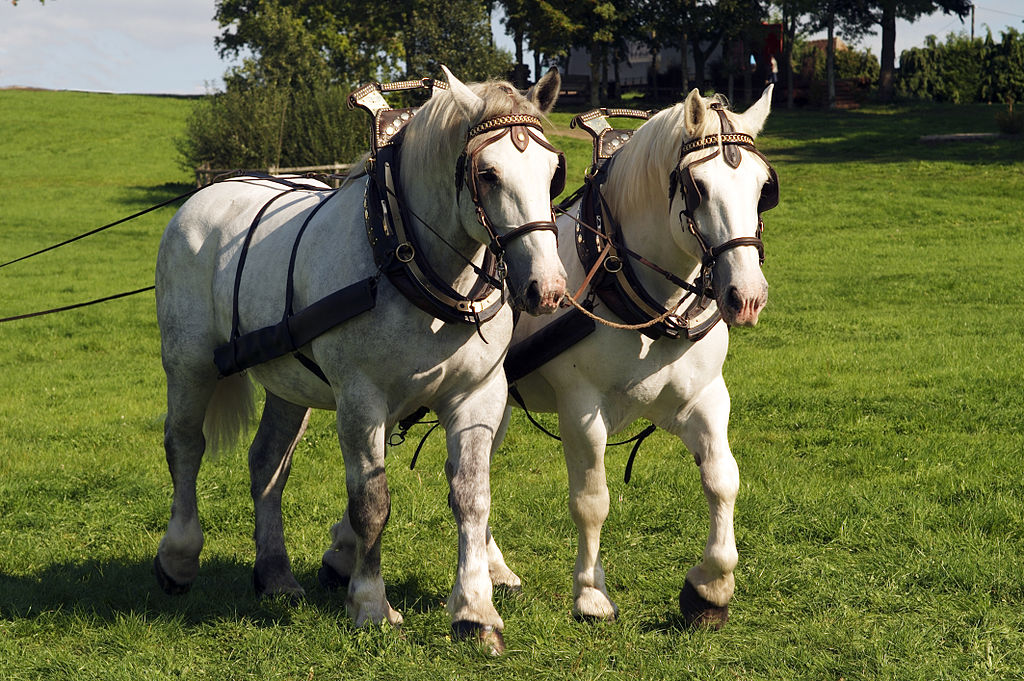The Percheron horse
The Perche region is the cradle of one of France’s oldest heavy horse breeds. From various local breeds, there was a strong oriental contribution after the capture of Arab cavalry during Charles Martel’s victory at Poitiers in 732. Later, the Counts of Perche also brought back Arab horses from the Crusades and Andalusian horses from Spain. Crossbreeding took place with Bearded horses, then in the 15th century with the English Thoroughbred. Its ancestors include two Arabian Thoroughbreds: Godolphin and Gallipoly, whose son, Fean le Blanc, is said to be the true leader of the breed, which was definitively established in the 19th century. In 1883, the Percheron Horse Society was founded, along with the Studbook, which was closed in 1911. Since 1966, the original Percheron and its offshoots (Trait Berrichon, Nivernais, Trait du Maine, Trait Bourbonnais, Trait de la Loire…) have been grouped together. In the 19th century, this prestigious breed was widely exported, which explains its presence on all five continents and its worldwide popularity.

Caractère et aptitudes du cheval
Percherons are good-natured, docile, and easy to handle. It is robust, enduring, energetic and capable of intense effort. Unleashed in action, its gaits are remarkable, long, low, and lively, supple, light, extended at the walk, as at the trot, with strong engagement of the hindquarters.
Utilisations du cheval
This versatile horse has been used as a steed, a carriage driver, a heavy draught horse on the farm and a skidder in the forest. It is now involved in a wide variety of activities, including advertising, leisure, and sports teams, Baneï (draught-tract) races and hiking. Improver of numerous draft horse breeds, it is crossed with the Thoroughbred to obtain heavy Hunters.
Morphologie du cheval
With its Arab ancestry, the Percheron is a harmonious, elegant, and distinguished horse. Fine head, broad, square forehead. Long, fine ears. Bright, protruding eyes. Straight, flat bridge of nose. Wide, very open nostrils. Erased ganache. Firm lips. Neck long and curled. Quite abundant manes. Extended withers. Shoulder long, strong, sloping. Chest broad and deep. Ribs long and round. Passage of straps very low. Back and loins straight and short. Full flank. Hips long and effaced. Croup long, straight, and slightly split. Tail set on high, in line with loins. Limbs clear and clean, plumb. Strong, well-developed forearms. Broad, muscular thighs. Buttocks deep, knees broad, square and in line with the shoulder. Broad hocks. Broad, flat, short cannons. Feet high and strong in heels. Gray or black coat, in all shades. Dapple gray and jet black are the most popular shades. Well furnished mane and tail. The initials SP, a sign of the Percheron equestrian society, are marked on the neck. Weight: varies from 600 to 1200 kg (average: 900 kg).
Height: from 1.55 to 1.85 m (average 1.70 m). The largest Percheron, Dr Le Gear, born in 1902, measured 2.13 m and weighed 1,372 kg.
In the past, two types were described:
- The small Percheron or letter carrier’s Percheron (1.50 to 1.65 m; 600- 800 kg): stagecoach, tramway, and omnibus horse.
- The Big Percheron (1.65 m to 1.80 m; 800 to 1,000 kg): farm horse.
Today we distinguish:
- The Trait Percheron: large, weighing over 700 kg, intended for farm work, skidding and heavy draught. The ideal type sought after by the Japanese.
- Diligencier Percheron: much thinner, less heavy, with an extended trot, appreciated for sport and prestige driving, fast drafting and under saddle. This is the most popular type in North America. In fact, to lighten the breed, France imported a light American stallion, Silver Shadow Sheik, in the 1990s.


